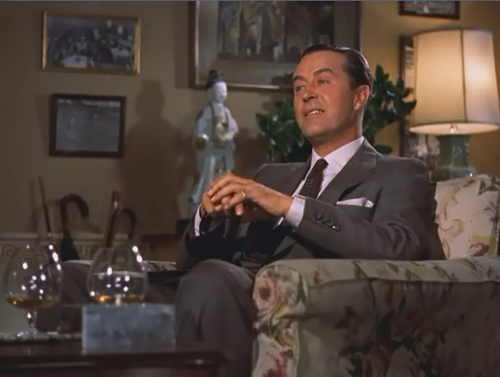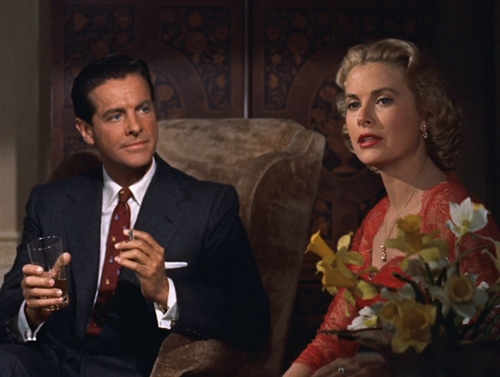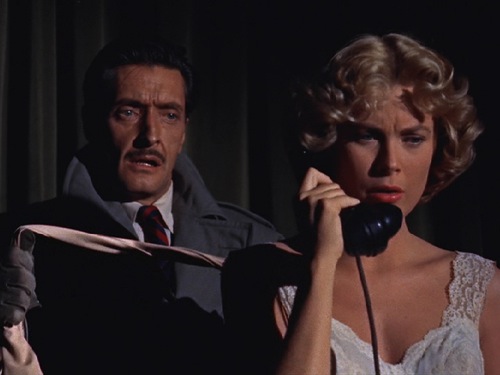Dial M for Murder/1954/Warner Bros. Pictures/105 min.
A streetwise femme fatale she’s not. Grace Kelly is too refined, too ladylike, too exquisitely beautiful. But in “Dial M for Murder,” her first movie with Alfred Hitchcock, she proves herself to be a smart and capable heroine in this film that’s nearly as ravishing to look at as she is.
We first see her character Margot Wendice, in a demure white dress, as she reads the London Times over breakfast with her debonair husband Tony (Ray Milland). Tony’s a former tennis champ who now sells sports equipment. But it’s Margot’s family money that pays for their posh lifestyle and elegant flat in Maida Vale.
Minutes after her breakfast, we see Margot with her lover, a mystery writer named Mark Halliday (Robert Cummings), this time in a bright red dress that signals where her real passion lies. Margot is fretting a bit because she’s received letters from an anonymous blackmailer who knows about her affair and threatens to tell Tony.
Turns out, though, the “blackmailer” is suave old Tony himself. He’s known for quite a while that Margot and Mark are an item and he’s hatched a plan to do away with his wife, get her money and use her lover as his alibi. It’s a very clever plan and Tony has worked out every detail. But as I mentioned Margot is no slouch. She proves quite skilled at surviving and improvising with weapons. A little trick she picked up at boarding school, I expect. Still, Tony sees a chance to achieve his goal using a new ploy.
Like most Hitchcock noirs, the story takes place in a world in which manners and titles and accents count for a great deal – in which fate is determined over champagne cocktails and glasses of brandy by a roaring fire. This chi-chi, upper-crust milieu is far removed from the gritty, urban, angst-ridden territory of much of the film noir canon. But a common thread of film noir, regardless of setting, is that its writers and directors were intensely aware of class differences and divisions, of society’s inequalities and injustices.
With a screenplay by Frederick Knott (based on his Broadway and West End hit), “Dial M for Murder” boasts a very civilized, very English, very cozy atmosphere, at least on the surface. Whereas Hitchcock often tended to use novels and short stories as gestalts for his own uniquely original narratives, when he chose to film a play, he left them virtually unaltered. In fact, he considered “Dial M” a minor work, something to do while he recharged his creative batteries.
That said, he shot the movie in 3-D, in vibrant color with extreme camera angles to keep us from getting too claustrophobic (the action takes places almost entirely in the Wendices’ well appointed flat). The lush look, upbeat mood, romantic music by Dimitri Tiomkin and charming characters all belie the darkness at the core of the story.
Milland is magnetic, confident, perfectly composed with just a shimmer of vulnerability. Kelly, the flawless incarnation of ’50s femininity, seems the perfect wife for him. (The supporting cast is splendid as well. Anthony Dawson plays the college acquaintance whom Tony ropes into his scheme. John Williams is urbane as ever as Chief Inspector Hubbard.) But, as sumptuous as these appearances are, they are nevertheless deceiving.
“Dial M for Murder” is an excellent example of one of Hitch’s favorite mind games – inviting us to get swept up in this picture-perfect world and then upending our expectations and revealing his (and perhaps our) mistrust of the upper classes, particularly through the use of subversive casting.
For instance, Margot and Mark’s fling is surely one of the most tasteful and thoroughly dull affairs in movie history (despite the red dress). I reckon any woman would take sexy, athletic Tony over sweet but insipid Mark. Of course, Hitchcock knows this. He uses Milland’s humor and appeal to build the audience’s sympathy for the wrong person, to get us to identify with a would-be killer, to subtly underscore the moral ambiguities and deep flaws that make us human.
Hitch liked to play cat and mouse with the audience, to entice us with wit, gloss and visual flair, then slyly expose our delusions and hypocrisies. Or as Francois Truffaut put it: “Hitchcock loves to be misunderstood, because he has based his whole life around misunderstandings.”













From FNB readers